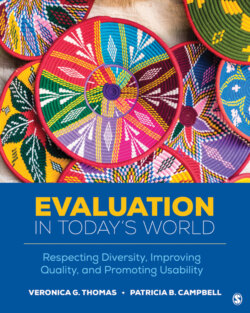Читать книгу Evaluation in Today’s World - Veronica G. Thomas - Страница 35
На сайте Литреса книга снята с продажи.
Culture, Cultural Competence, and Cultural Responsiveness
ОглавлениеThroughout the book, there are many references to culture and the importance of cultural competence.
While there are almost as many definitions of culture as there are cultures themselves, this definition, from the Center for Advanced Research on Language Acquisition (CARLA) provides a perspective that may be useful to evaluators. They define culture “as the shared patterns of behaviors and interactions, cognitive constructs, and affective understanding that are learned through a process of socialization. These shared patterns identify the members of a culture group while also distinguishing those of another group” [CARLA, 2019, para. 1]. While we often think of culture groups in terms of ethnicity or nationality, they can be any group with shared patterns of behavior and understandings such as evaluators, scientists, or even Boston Red Sox fans (Campbell & Jolly, n.d.d, para. 1).
Culture is a powerful organizing framework that both filters and shapes perceptions, communications, values, and subsequent behaviors. As Table 1.3 shows, response to superficial areas such as what protein to have for dinner can cause strong visceral reactions.
Table 1.3
Just as many people in the United States, for example, will have a strong visceral reaction to the idea of eating bugs, many people in India will have the same reaction to eating beef. As part of cultural awareness, it is important to learn more about why those in different cultures make the choices they do. As discussed in more detail in Chapter 5, evaluators must have a genuine willingness to learn about the cultures with which they engage within the evaluation context and, as appropriate, a willingness to suspend judgments. They also need to cultivate a belief that cultural diversity is a source of strength and enrichment rather than a deficit or obstacle to overcome (Handford, Van Maele, Matous, & Maemura, 2019). Evaluators need to be aware of the major culture groups that may have relevance for different evaluations. For example, the culture of different institutions of higher education (i.e., Ivy League, large public, historically Black) might be pertinent for an evaluation of a higher education program while the culture of correctional faculty (i.e., maximum, medium, or minimum security) might be pertinent for an evaluation of in-house recidivism programs. Other cultural groups might be important in different evaluations. However, it is important to remember that “accurate predictions of individual behavior based on nationality or other collective-level categories are typically not possible and may even cause offense. We are all members of multiple different groups and these identities become relevant at varying moments of our day” (Handford et al., 2019, p. 45).
As covered further in Chapter 13, how participants in programs and projects being evaluated identify themselves or how they are identified by others is one way to help evaluators understand cultural group memberships that may be salient for the evaluation. Learning about what is currently going on in relevant institutions and the surrounding communities can also help to identify other salient factors. Evaluators need to have ongoing knowledge and understanding of the cultural groups and related factors.
As covered in greater detail in Chapter 5, evaluators need to be culturally competent, and their evaluations need to be culturally responsive. SenGupta, Hopson, and Thompson-Robinson (2004, p. 13) go beyond the relatively simple definition of cultural competence given in the beginning of this chapter to describe cultural competence in evaluation as a “systematic, responsive inquiry that is actively cognizant, understanding, and appreciative of the cultural context in which the evaluation takes place; that frames and articulates the epistemology of the evaluative endeavor; that employs culturally and contextually appropriate methodology; and that uses stakeholder-generated, interpretive means to arrive at the results and further use of the findings.” Cultural competence in evaluation takes place through a continuing open-ended series of substantive, ethical, and methodological insertions and adaptations that aligns the inquiry process with the characteristics of the groups/contexts being examined.
It is not enough for evaluators to embrace cultural competence, but as covered in detail in Chapter 5, evaluators must mindfully apply that competence to every aspect of their work from evaluation planning to reporting and use of results. Additionally, cultural competence is important in evaluation scholarship and in evaluation educational and professional development settings.
One of those areas where this was evident for us was in determining the most culturally appropriate terminology to use throughout this book to describe people from different races/ethnicities. There are many different ways to do this, and there is no one right answer. It is particularly difficult because of the practical necessity of using one term to collectively describe diverse subgroups. Our choice has been to acknowledge the complexity and be transparent about the choices we made. Since Asian American is the common term for people in the United States of Asian descent, we chose to use that term, knowing that it doesn’t acknowledge the great diversity within that group. We were unsure as to whether we should use American Indian or Native American to collectively identify members of the 562 different tribes in the United States. We asked three people from different tribes who are very active in their tribal communities for advice. While they have used American Indian in the past, their preference is for Indigenous People, which is the term we are using.
We chose to use the terms African American and Black fairly interchangeably; however, we tend to use African American when we refer to people whose origins are in the African continent but whose history is on the American continent and Black when we are speaking more generally. We also chose to use Hispanic as a generic collective term because it encompasses people from outside as well as inside Latin America.
